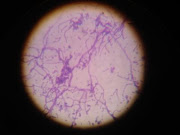MDPI
Diseases 2021, 9, 80.
https://doi.org/10.3390/diseases9040080
Antibiotic Susceptibility,
Biofilm Production, and Detection of mecA Gene among Staphylococcus aureus Isolates from Different Clinical Specimens
Upama Gaire1, Upendra Thapa Shrestha1,
Sanjib Adhikari1, Nabaraj Adhikari1, Anup Bastola2,
Komal Raj Rijal1,*, Prakash Ghimire1 and Megha Raj
Banjara1,*
1Central Department
of Microbiology, Tribhuvan University, Kirtipur, Kathmandu 44600, Nepal
2Sukraraj Tropical
and Infectious Diseases Hospital, Teku, Kathmandu 44600, Nepal; docanup11@gmail.com
* Correspondence:
komal.rijal@cdmi.tu.edu.np (K.R.R.); megha.banjara@cdmi.tu.edu.np (M.R.B.)
ABSTRACT
The increasing incidence of
methicillin-resistant and biofilm-forming S. aureus isolates in hospital settings is a
gruesome concern today. The main objectives of this study were to determine the
burden of S. aureus in clinical
samples, assess their antibiotic susceptibility pattern and detect biofilm
formation and mecA gene in them. A
total of 1968 different clinical specimens were processed to isolate S. aureus following standard microbiological
procedures. Antibiotic susceptibility test of the isolates was performed by
Kirby–Bauer disc-diffusion method following CLSI guidelines. Biofilm was
detected through tissue culture plate method. Methicillin-resistant S. aureus (MRSA) isolates were screened using
cefoxitin (30 μg) discs and mecA gene was amplified
by conventional polymerase chain reaction (PCR). Of 177 bacterial growth, the
prevalence of S. aureus
was
15.3% (n= 27). MRSA were
55.6% (15/27) and 44% (12/27) exhibited multidrug resistance (MDR). There was no
significant association between methicillin resistance and MDR (p > 0.05). Both MRSA and MSSA were least sensitive to
penicillin (100%, 75%) followed by erythromycin (86.6%, 66.6%). Most of the MRSA
(93.4%) were susceptible to tetracycline. All S. aureus isolates were biofilm producers—19 (70%)
were weak and only one (4%) was a strong biofilm producer. The strong
biofilm-producing MSSA was resistant to most of the antibiotics except
cefoxitin and clindamycin. None of the MSSA possessed mecA gene while 8 (53.3%) MRSA had it. More than half of S. aureus isolated were MRSA. High incidence of
multidrug resistance along with capacity to form biofilm among clinical
isolates of S. aureus
is
a matter of apprehension and prompt adoption of biosafety measures is suggested
to curb their dissemination in the hospital environments.
Keywords: S. aureus; antibiotic susceptibility; MRSA; mecA gene; biofilm
Citation: Gaire, U.; Shrestha, U.T.; Adhikari, S.; Adhikari, N.;
Bastola, A.; Rijal, K.R.; Ghimire, P.; Banjara, M.R. Antibiotic Susceptibility,
Biofilm Production and Detection of mecA Gene among Staphylococcus aureus Isolates from Different Clinical Specimens. Diseases 2021, 9, 80. https://doi.org/10.3390/diseases9040080
Academic Editor: St Patrick Reid
Received: 9 October 2021
Accepted: 29 October 2021
Published: 1 November 2021
Publisher’s Note: MDPI stays neutral with regard to jurisdictional claims
in published maps and institutional affiliations.
FULLTEXT: Download






















